The West Country Times Tuesday April 5, 2016
It’s over 40 years ago since the air crash that left hundreds of West Country families in mourning for mothers, daughters, grandmothers, aunties and nieces. An English oak tree in a pine forest on a Swiss mountain marks the spot of the tragic plane crash on April 10, 1973, which killed over 100 people, mainly mothers. Thirteen headstones in Axbridge cemetery are a reminder closer to home of that terrible day when a chartered aircraft, flying from Bristol’s Lulsgate came down in the snow near Basle. The Swiss air disaster, as it became known, tore the heart out of many villages in North Somerset and the Cheddar valley – the first time that an air disaster had killed so many people from one area.
The 108 victims were from Axbridge, Cheddar, Congresbury, Claverham, Wrington, Weston- super-Mare and Bristol. The actual flight in the Invicta International Airways Vanguard a much anticipated shopping and sightseeing trip had been uneventful. But as the aircraft approached Base airport it hit a blizzard and began bumping badly. At 10am, after aborting one at- tempt to land, the pilot circled again and was given permission to approach for a second time. Thirteen minutes later Swiss air traffic control requested the plane’s height – the pilots reported it as being at 1,400 feet. It was to be the last message from the Vickers Vanguard as, 30 seconds later, the aircraft struck a tree, flipped across a snowy valley, and crashed into dense woodland. It was a tragedy every- one from this clutch of West Country towns and villages knew of a family who had lost someone. In the North Somerset village of Congresbury not one of the 20 day- trippers would return home. As 77 women lost their lives so 45 children were left either mother- less or orphaned. But there was more distress to come. A damning report into the accident disclosed a shameful catalogue of blunders, botched re- pairs, instrument error and human failure. Worse still it appears the disaster could have been averted if air traffic control had reacted correctly. Many said that the flight should never have taken place – that the plane should never have taken off. To start with the trip from Bristol’s Lulsgate airport was delayed when had been the company had been organising it had gone bust the previous which week.
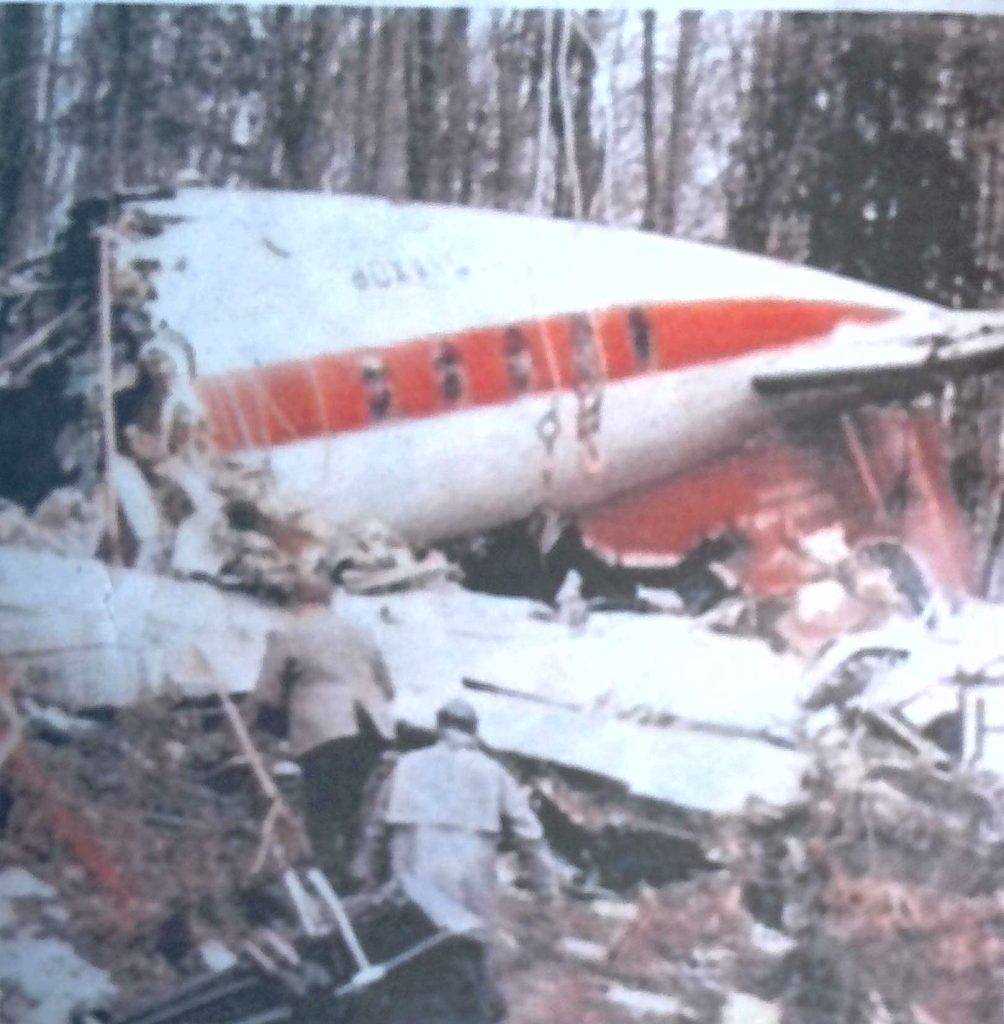
Despite this the visit, which had been the talk of mothers’ groups and various village organisations for months, was eagerly looked forward to.
One hundred and four passengers, along with four crew, died “I had to repatriate 20 bodies from Switzerland and arrange funerals for people I knew well’ Andrew Sheppey who had to take over the family funeral business after his aunt and uncle were killed in the Swiss air disaster with thirty-five passengers and one hostess being injured. Another hostess, by some miracle, remained unhurt. Conditions over the mountains were pretty awful with the landing hampered by heavy snow, low cloud and poor visibility On top of this poor reception of the medium wave beacons, a report said, would have made navigation on board the aircraft difficult.
The landing systems not yet upgraded just weren’t good enough to assist the pilot and crew in such severe weather conditions. As the four-engined turbo prop lurched sickeningly through low cloud a retired Swissair pilot, alarmed to see it just overhead, telephoned air traffic control. I have the impression that if it remains like this it will crash into the mountains” the retired pilot told them. The controller agreed but only told the plane it was off course 30 seconds before impact. A recording, made just five minutes before the crash, confirmed that it was snowing very heavily. Surely, people said, warnings of a storm brewing should have led to the flight being postponed – or at least prompted the crew to seek an alternative airport.
Two hours went by before a search and rescue team set off for the scene of the tragedy. It then took the team 45 minutes to find the wreckage with the first of the injured being taken to hospital some 30 minutes later. Low cloud ruled out the use of helicopters and a great deal of time was lost because access roads were only passable using cross- country vehicles. The rescuers, mainly gendarmes and Swiss army recruits, had to work in deep snow and difficult conditions to ferry the survivors to hospital. Many said later that they had carried out this harrowing and difficult job with utmost dedication. The dead – over 100 were counted – were taken to a temporary mortuary in a school gymnasium. In order to bring back relatives and survivors, some of them still injured, airline boss Freddie Laker provided a DC10 free of charge.
Over the intervening decades many relatives and survivors have travelled back to 1973 tragedy the scene of this to mourn and to pay their respects to the dead. Now, as time goes by, those numbers are getting fewer and fewer but the tragedy, one hopes, will never forgotten. Local rare be breeds farmer Andrew Sheppey lost an uncle and aunt, William and Dorothy Price, leaving him with the responsibility of taking on his uncle’s business as the local undertaker. Mr Sheppey said on a recent anniversary of the disaster: “There were two funerals already imminent, but I also had to repatriate 20 bodies from Switzerland and arrange funerals for people I knew well.’ Villager Connie Wookey was among a group from the Congresbury Ladies Skittle Club who were planning to make the trip to Switzerland but cancelled because her husband had a bad feeling about the trip. He later said he had dreamt of an a accident in wood, and Connie, who was a Gill before she married, lost five members of her family in the tragedy. A copy of the original report about the crash tells how the whole village was “hushed” by the disaster and how the local community rallied around to support those who lost loved ones. The funerals of the 20 people a who died in the crash were all conducted at St Andrew’s Church, and many of the victims are buried in the churchyard.
Decades have not dimmed memories of dark tragedy
Perhaps it was fate, but something made my mum turn down the offer of going on that day-out to Switzerland. I clearly remember her being invited. It was at a bonfire night party the previous November at the neighbour of her closest friend. The fireworks had finished and we were inside eating hot-dogs while the grown-ups were having a drink. The woman I remember was a welcoming and glamorous host and someone who was always at the centre of the conversation. I recall her talking about the planned shopping trip to Basle. She turned to mum bright eyed and imploring: “Why don’t you come with us. It’s only for a day,’ she said. My dad had died suddenly five years earlier and my mum answered without a moment’s hesitation. “No I don’t want to risk it, just in case, pointing at me. The woman who had asked her said: “Oh you still would be fine. But s mum aid no. Perhaps something told her not to go although I suspect the reason was more prosaic. She probably could not have afforded it. My mum’s best friend was also at the party and she too was asked to go. She initially said yes but then pulled out, at least that’s how I remember it.
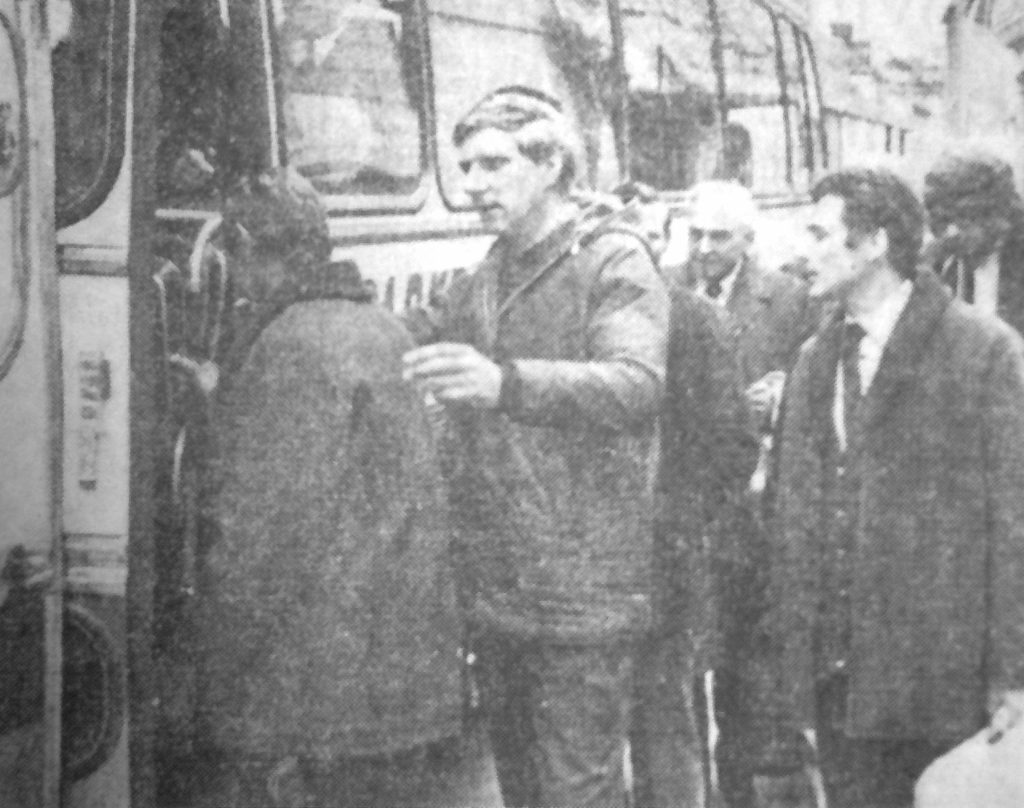
In any event she didn’t go. Five months later she and mum waited anxiously for news. I recall vividly the following morning my mum tuning into Radio Bristol where Roger Bennett read out the names of those who had survived. Mum listened in a tense unbroken silence as Roger read out the list of survivors knowing the importance of every name he uttered. The names mum was waiting for did not come. When he got to the end of the list mum looked at me tearfully and said: “They aren’t there.
The woman from the party, together with her sister had both perished when the Invicta Air- ways flight came down in woods. It was one of those times when you literally do not believe what has happened. A few days later we were in the garden of a friend’s house and we saw the son of the woman who had asked mum to go on the flight walking by. We called him in. We were 13 at the time and really not sure what to say. One of my friends said: “Sorry about your mum. And the rest of us said “Yes”, He replied: “Yeh, thanks.’ Then we played football for a bit. But we felt terrible for him. His life had changed forever. Like many 45 other children his mum again. would never come home.
Just round the corner from where I grew up was a florist shop. I was at school with the daughter of the couple who ran it. Her mum was also among the dead. For years afterwards she would always wear black on the anniversary of the crash though she never spoke of it and I never asked her. But I was always touched by that simple, solemn gesture, acknowledging that fateful date each year.
It doesn’t matter how many years pass those of us who remember the Swiss Air Disaster, as it came to be known, will always feel moved by its mention and the memory of those who left for a happy day out and who never returned
Moving memorial services over the years to remember those who died
Over the years there have been many visits from Somerset to Switzerland to mark the successive anniversaries of the crash which claimed so many lives from the area. Here we reproduce a report by former Western Daily Press features writer Roger Tavener who joined the families and survivors travelling from the West Country to Hochwald, Switzerland, in 2003, the 30th anniversary
The grief was too much too bear and the tears flowed as freely as the snow fell mournfully from an ashen sky. It was on this day 30 years ago 108 people, mostly mothers from Somerset’s Cheddar Valley, died when their plane, taking them on a day trip from Bristol to Basle, became lost in a blizzard, and smashed into a Swiss mountain. Fate had decreed that the elements. would, on this morning of all mornings, conjure a haunting echo of that terrible day.
The gods had been cruel that day. And now they were being downright unkind. The irony was unmistakable. Crash survivors and victims’ relatives made the sad journey from the West by road and sea to the tiny alpine village of Hochwald, near Basle.
They were happy and 108 Number of people who died in the Swiss Air disaster, mainly West mothers cheerful on the two coaches which climbed the mountains towards the crash site, but suddenly there was an awful silence when snow began to fall.
This was uncanny. It is unusual for this part of Switzerland to be hit by snowstorms in early spring. Previous days had been sunny and warm and dry. The first flakes began to fall at dawn and it snowed all day long. Sylvia Cole, who survived the crash which killed so many of her friends said: “The horror of it all came back in a flash when we saw snow and we were swamped with the memory of that morning. “This is exactly what it was like then. We can’t believe it.” Sylvia wasn’t saying it to anybody, but she could now vividly remember coming round and when she undid her safety belt she was upside down and she plunged onto two corpses. In private moments she admits life doesn’t really prepare you for that kind of thing.
The coaches dropped them on a mountain track, steep and winding from the village of Hochwald, past the deer and rabbits and golf course and the cherry tree which produce the local speciality, Kirsch. From there it was a 300 yard walk through the pine forest to a farm, Herrenmatt, it means Mister’s land, the scene of Switzerland’s only civil air disaster.
In a country as pristine and proud as this, that is a stain on its unblemished reputation. Three hundred yards was an easy stroll for Hazel Lane thirty years ago. Now the 69-year-old could only make the distance by summoning up all the willpower she could muster. The willpower that kept her alive that day she looked death in the face and said to herself: “I’m not ready for this.” Despite being horribly injured and with medics preparing to amputate her legs, Hazel flashed them her trademark smile and said “No thanks. They’ll get better.” They didn’t quite. Hazel, who with husband Ken ran Cheddar’s biggest shop Lanes, has under- gone 12 operations since the seven weeks she spent in a Basle hospital until she was well enough to be airlifted back to England and then hospitalised again. The physical pain has never left her, not for one day. Everyone in the seats in front of Hazel perished. Many behind died. She was surrounded by four close friends. All were dead. Blood was pouring from her leg wounds, but she refused to go quietly. Hazel wasn’t going to go at all. As she stood in the snow at the spot which claimed the lives of so many friends she said: “We were numb. “Not just because of the cold. I kept moving my fingers because I remembered that was a way of keeping the circulation going and not fainting. “I wanted to go to sleep but wouldn’t let myself. I thought that would be the end if I did. “It’s not easy to walk, but I can and am still alive. I had to come here to remember. It has been very emotional up here, more than I thought. “Suddenly it all comes back and you see the faces of your friends. You can never prepare for this it always gets to you.”
Some of the 39 survivors and many of the victims’ children and grandchildren made it to the memorial garden on the hillside, where the Vickers Vanguard tore through the hillside ripping through pine trees.
The rear end survived. The front disintegrated
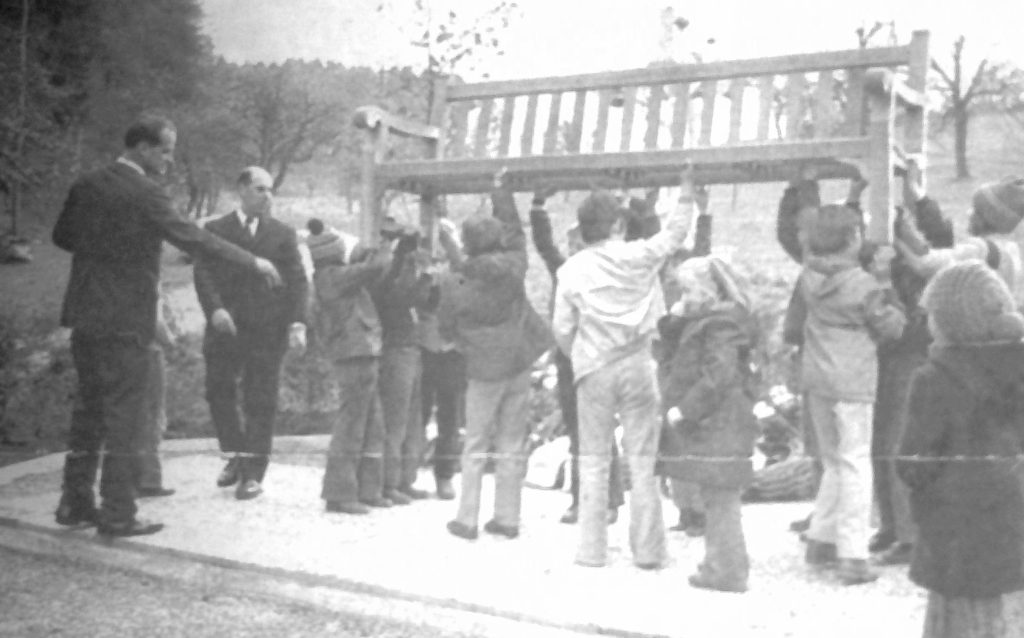
The scene is an area of outstanding natural beauty You can sense the shame that it is best known for the catastrophe from the sky at 9.13am when the plane missed the runway for the second time and ditched. Now there is a huge hunk of rock and a modern art sculpture representing an aircraft.
Spring flowers bowed their heads yesterday as the snow weighed them down. And under a flagpole flying the Union Jack, one by one in utter dignity, the West Country folk laid their wreaths and bouquets. Bright, colourful bunches of roses and crocuses and lilies. They planted an English oak tree and placed a seat, where generations will be able to sit and contemplate. Men and women and children weren’t ashamed to cry here, such a beautiful place yet custodian of so many terrible memories.
That day it had been a vision of hell and people lost their lives. ‘Suddenly it all comes back and you see the faces of your friends. You can never prepare for this it always gets to you’ Survivor Hazel Lane who was injured in the crash which killed many of her friends 60 savage seconds. Strangers held each other and only those who knew what had happened in this place could understand. It was their time, and they would comfort each other.
And a plaque which says simply in masterful West Country under- statement: “April 2003. Placed here by the family and friends in memory of the 108 people who lost their lives 30 years ago.”
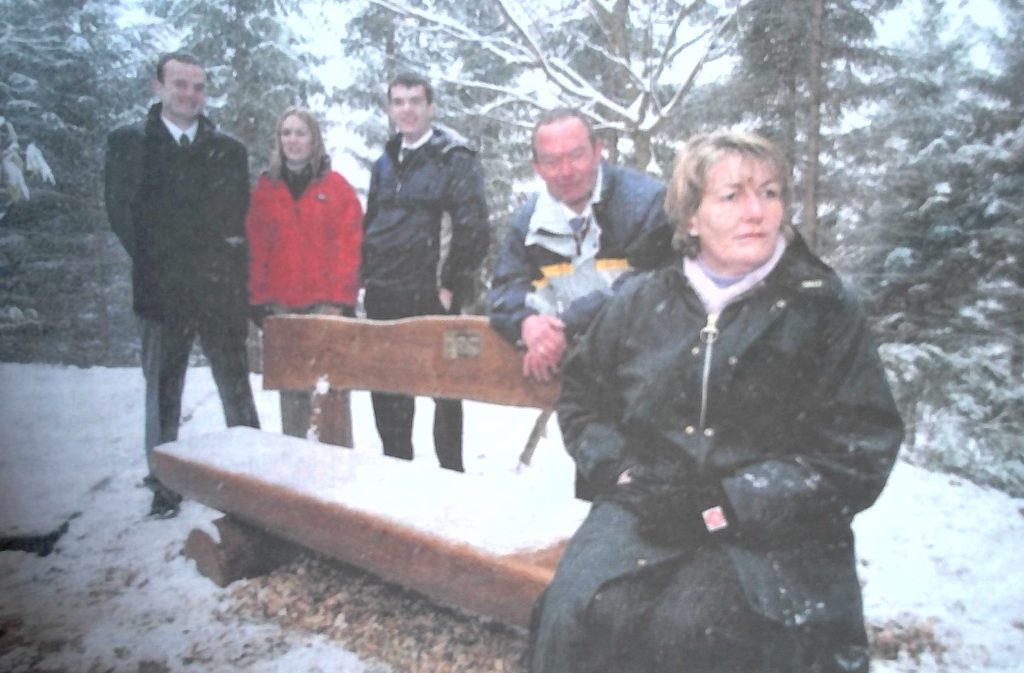
The visit had been organised by Mike Latham and his wife Gill. He lost his mother. She lost both parents and four other family mem bers. Their three children had never been to the crash site and had never known their grandparents. Daughter Emma, 23, from Cheddar, said: “I had never been here and I am surprised how emotional it was. It brings it home when you stand there and realise what went wrong.’
During a packed service later at the nearby St Gallus’ Church in Hochwald, local Church of England vicar Geoff Read said it was a time to look and remember the past, but also a time to move on. Emma said: “When it snowed the coaches fell silent. You could sense the memories that were returning. It was a very tough time for my parents, but they met through the crash. “And here I am with my brothers. We wouldn’t have existed if the crash hadn’t happened so even out of something as so even out of something as terrible as this some good comes.”
Survivor who lived with painful legacy until she died
When Hazel Lane died in April 2007, moving tributes were paid to the woman who so often became the face of the 39 survivors of the Base air disaster. The mother had been one of the 147 passengers who left Bristol Airport for a springtime shopping and sightseeing trip to the Swiss city. Mrs Lane, of Cheddar, was travelling with four close friends from St Andrew’s Church Mothers Night Out Club, who all died. But she survived and died at Weston General Hospital from heart failure and Alzheimer’s disease a the age of 78.
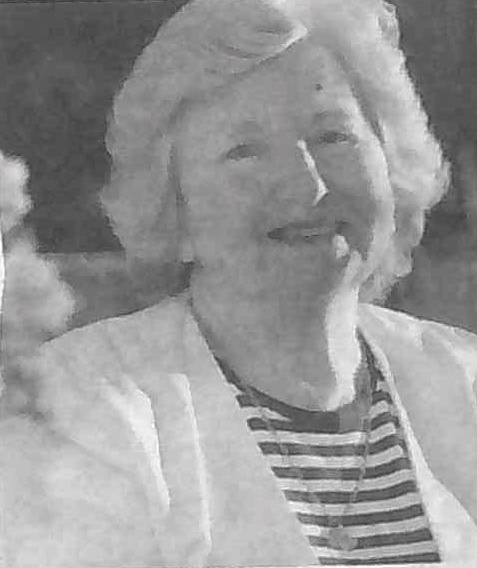
At the time of her death her husband Ken, 80, said: “Hazel was extremely brave and was the perfect wife during our 56 years of marriage, but she never ever fully recovered from the crash.’ She was the only survivor among five women from the St Andrew’s Church Mothers’ Night Out Club in Cheddar. Mother-of-four Mrs Lane was sitting next to the wing while her four friends who died were sitting immediately in front of her. She was trapped in the plane for more than two hours fighting for her life before local mayor, the late Erst Graft, who became a close family friend, pulled her free by using his walking stick to hook on to her collar.
At first, husband Ken thought she had died – because for 24 hours her name was missing from the survivors’ list. He and son Graham dashed to Basle to investigate, the first relatives to reach the hospital. There, badly injured, she was among six unidentified survivors. When asked by rescuers for her name, she had muttered “Hazel” and they assumed she meant Mrs Hazel. She broke both her legs, one arm and ribs, and spent seven weeks in a Swiss hospital before becoming the last survivor to return home.
Even then it was a long time before she able to walk with the aid of a stick and she lived with the pain from her injuries every day She once said: “I went to the 20th anniversary reunion and it was very traumatic but they had done it really well. “My husband usually takes out on me the day of the anniversary so that I don’t stay in all day thinking about it.’
Woman honours memory of five loved ones killed on a single day
Rosemarie Pitts lost her mother, father, brother, aunt and nine- year-old cousin in the Basle air crash. She was then aged 25 and six months pregnant with her first son, Matthew. Her parents Ivor and Marie Gill, brother John, aunt Aleen Gill and her young cousin Hazel were remembered when Rosemarie made a pilgrimage to the Swiss mountainside for a special memorial service 30 years later. Rosemarie, who lived in Clevedon, kept a diary about her stay in 2003.
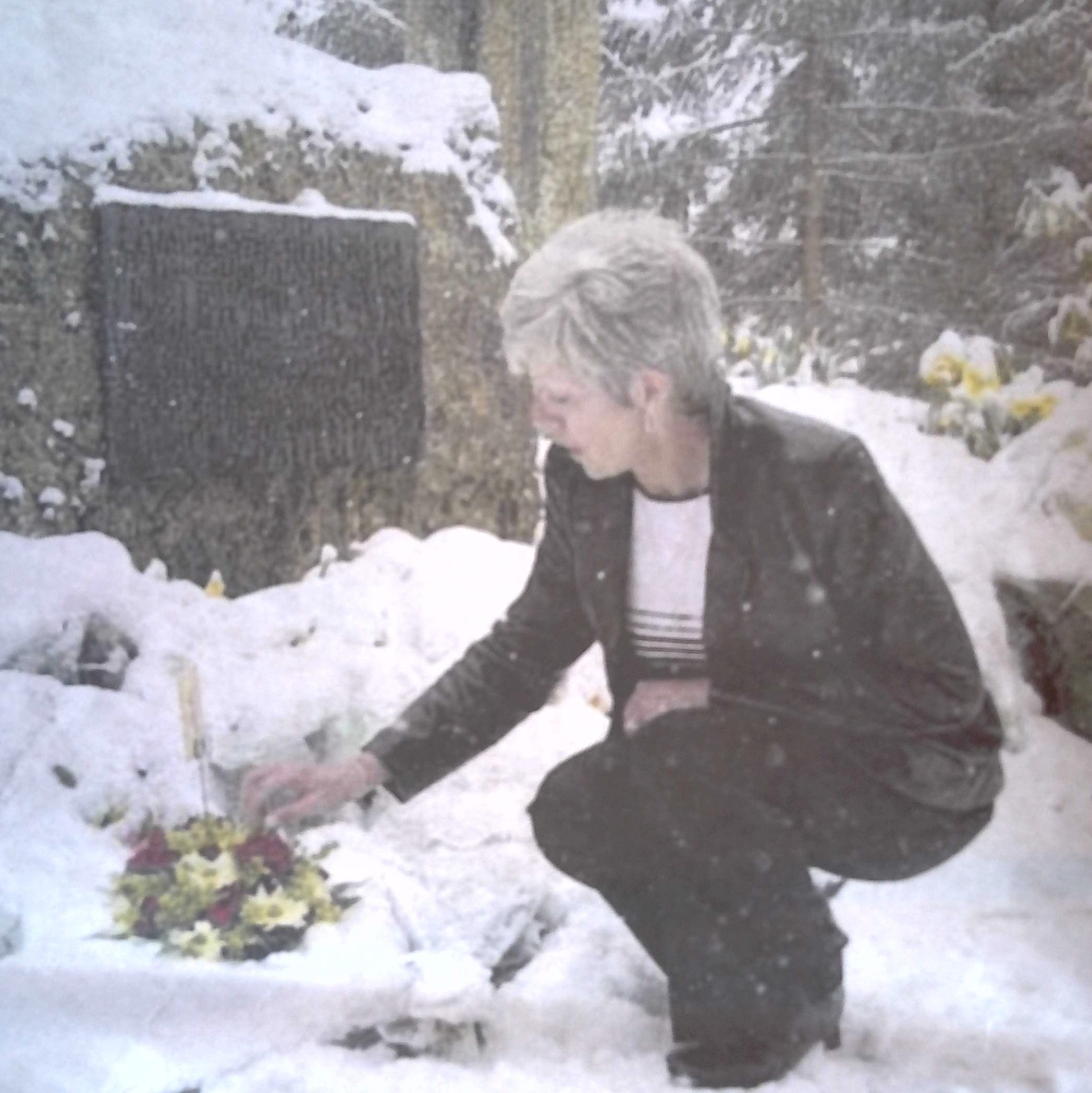
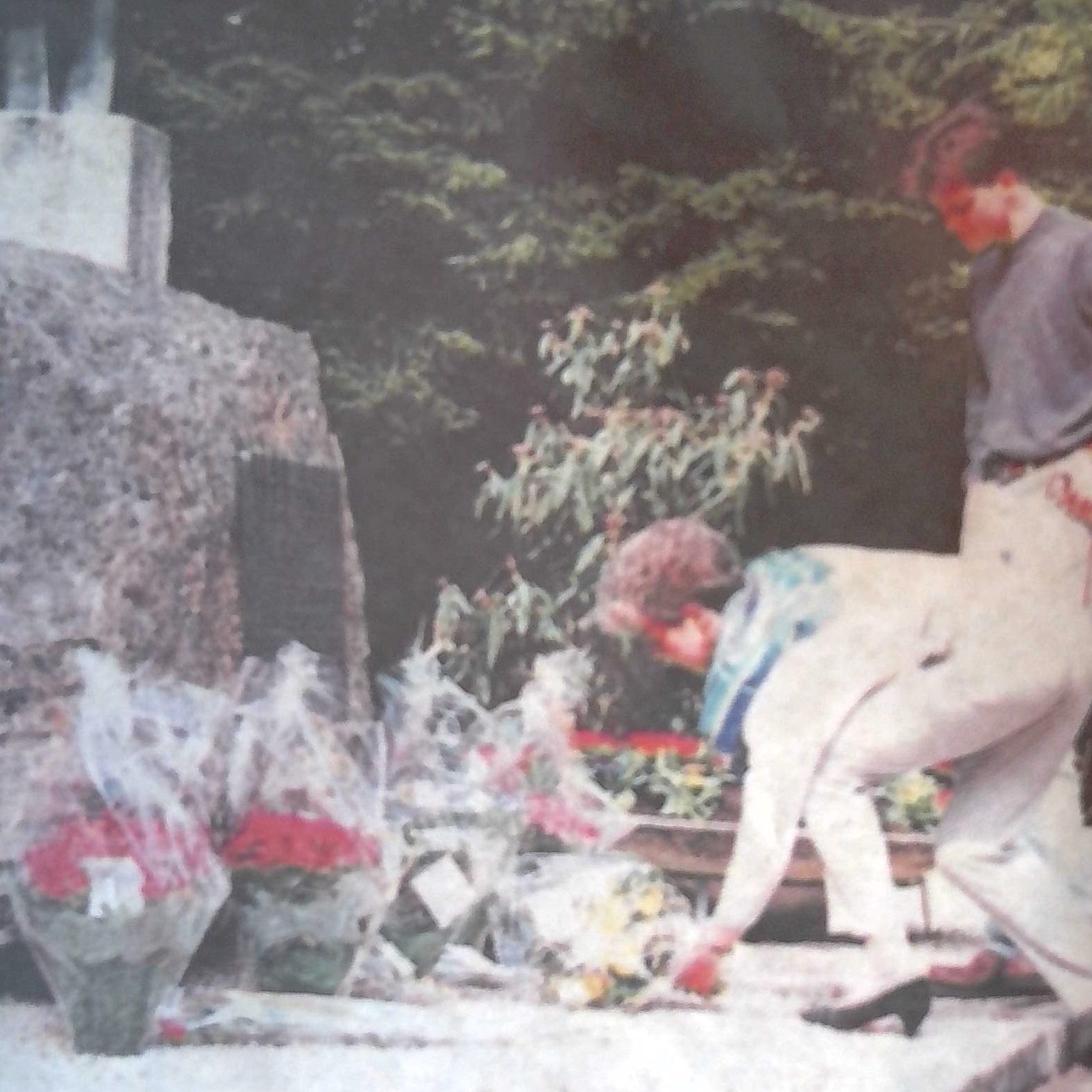
April 10
Today I will make a journey of remembrance to the tiny village of Hochwald where five members of my family died so tragically on this day 30 years ago. I feel a little nervous. It’s ten years since my last visit. Soon after take-off from Heathrow the pilot announces it is cold and snowing in Basle, just like 30 years ago. On arrival I am driven to Hochwald by a friendly face – Marlene Vogtli. It was Marlene’s sister who acted as an interpreter when the crash happened.
The winding road through the pine forests looks beautiful with its snowface. I meet the coach party of other relatives in the village hall. They have already been up to the memorial site an English oak tree has been planted in the forest, a symbol of England among the pine trees. A bench with a memorial plaque has also been placed there. Floral tributes too, more than 40 of them. I will make my own private visit to the site after the church service. The remembrance service, in English and German, ended with the hymn Now Thank We All Our God.
Tears are falling as we light candles. Later while it is still snowing heavily I visit the memorial site to pay a private tribute. Everything seems so ghostly. Silent, tranquil and later, at the hall, I meet people from Congresbury who lost their parents, those who were orphaned now returning with their children.
April 11
I wake up and the sun is shining and the snow is melting. A group of us walk to the memorial and notice among the flowers one from the British Embassy. Today we intend to do what those who died all that time ago intended to do go sightseeing and shopping. The first trip is in a cable car to Mount Pilatus, some 7,000ft high. At the top the air is clear and crisp, the sun dazzling and the views breath-taking. It feels like world. you are on top of the
April 12
Marlene and I visit the magnificent cathedral on the Rhine at Basle and look round the old city with its cobbled streets and find time to shop, everyone is buying Easter eggs.
April 13
Time to go home. One last visit to the memorial. We take off all the cellophane from the flowers which still look lovely despite the heavy snow. I linger briefly to touch the flowers, tears in my eyes. It’s time to leave with my memories and look to the future. The village undertaker is reported as saying: “Since the crash a local saying has developed that we can’t count on it not snowing until April 10 has passed.’ Since the tragic accident many endearing friendships have been formed by those who lost loved ones and the Swiss village closest to the crash site.
Rosemarie Pitts, from Clevedon, who lost five members of her family, is pictured: marking the 30th anniversary, top, and at an earlier memorial service in the woodlands, above, where her relatives died
Those left behind find ways to help survivors and honour the dead
As well as the anniversary visits to Switzerland, there have been many stories in the pages of the Western Daily Press about the air crash. Here we take a look at some of the reports as the personal stories of those involved emerged over the years April 1998
Relatives of 108 people, mostly Somerset women, killed in a Swiss air crash 25 years ago set out on a sad pilgrimage to the disaster site for a memorial service. Pictured above, some of a party of 51 relatives of the dead were travelling by coach to the village near Basle for a mountain memorial service at 10am the precise time of the disaster.
The coach set out from Cheddar and was met by families with whom they had kept in touch over the years. Mother-of-three Thelma Maunders, of Cheddar, whose mother, Doris Gould, died in the plane the day before her 60th birthday, organised the pilgrimage. She said: “It is all still so vivid in people’s memories but life has to go on. People have dealt with it in their different ways, but you never forget something like that which had such a profound effect locally on most families. When many of us visited the site a year after wards you could see where the aircraft had cut through the tops of the trees.
You can see Basle Airport from the crash site and, ironically, had they been 20 feet higher they would have cleared the trees and landed safely.” Crash survivor Susan Miles, 47, of Bridgwater, was in seat 13 and was hailed as a heroine for pulling casualties from the wreckage, and leading survivors in hymn singing as they waited for help in the snow-covered hills. She said: “I was momentarily knocked out in the crash but survived because I was in the tail section. I shall never forget the waiting in the snow. It was two hours from the time we crashed to when the emergency services reached us. The following September she married Richard Miles in Axbridge and the couple named their bungalow “Dornach” in memory of the kindness of nursing staff at the Swiss hospital.
Autumn 2002
Retired barrister Frank Buckley recalled his involvement in the disaster as assistant director of the British Red Cross. Mr Buckley, then aged 88, of Filton Avenue, Bristol, travelled to the crash site with 66 relatives and friends to help identify the victims. He said: “I arranged accommodation for the party, assisted at the mortuary and visited survivors in hospital at Basle. “The Red Cross picked me because I speak French and German and had experience of mass casualties in the Second World War. “The rescuers were mainly gendarmes and the Swiss Army and they had to work in deep snow and difficult conditions to ferry the survivors to hospital.
They also had to recover the bodies which were taken to a temporary mortuary in a school gymnasium at Dornach. “I assisted by finding accommodation, counselling the 66 relatives and organising the mass funeral in the village’s Catholic Church two days later. In order to bring back the relatives and survivors, some of them still injured, I contacted the airline boss Freddie Laker who provided a DC10 free of charge. Some of the seats had to be taken out so that four stretchers could be bolted to the floor for the badly injured. We then flew back to RAF Lyneham in Wiltshire.’
October 2003
A woman asked Cilla Black to help keep the memory of her best friend alive. Thelma Raisey never forgot her friend Alison Young, who was 23 when she was killed in the Basle air disaster. Cilla was Alison’s idol and Thelma travelled to Asda, Patchway, to meet Cilla who was signing copies of her new book, What’s It All About? After a chat Cilla signed a copy: “In loving memory of Alison. Lots of love, Cilla.’ Mrs Raisey said Alison was her best friend and was going to be the godmother of her son Michael. Alison was a fan of Cilla and had had all her records and would try to imitate her. She had her hair done in the same style.
May 1999
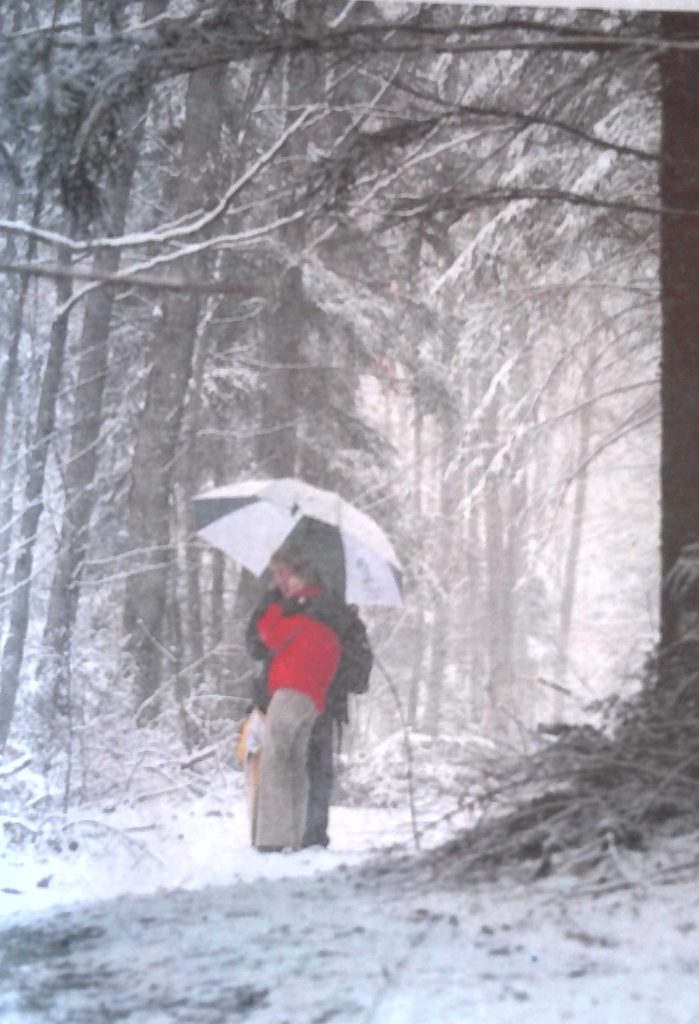
rusts set up at the time of the tragic Base air disaster were wound up. Several funds were started by churches, villages, Rotary, Round Table and the Lions to ease the immediate problems of the families left behind. Money raised in Britain was incorporated into the Hochwald (English) Trust, which was divided into equal shares and distributed to the survivors, the spouses and children of the deceased.
Police in Switzerland, touched by the tragedy, raised £60,000, which became the Hochwald (Swiss) Trust. fund, The fund had distributed £169,000 when it was wound up. Chairman of the trustees, the Preb Ronald Denman, who was vicar of Cheddar at the time of the tragedy, congratulated fellow trustees Stella Clarke, Barney Lovell and Ken Collins and commended original chairman John Walter and treasurer Alan Jennings, both of whom died that year, He also thanked the original secretary Margaret Tucker and the first treasurer Tom Smith, who had worked hard to make the distribution fair and non-controversial. “It was particularly noted that, since no huge appeal had been launched at the time, the funds remained manageable and distribution had been possible without, in the main, the jealousies and envy which often affect larger disaster funds,.” said secretary Sue Underhill.
December 1999
Bristol International Airport created an exhibition to celebrate the forthcoming opening of a new £27 million terminal. Among the guests was 77-year- old Lena Simmons, who contributed an image of a memorial erected in Switzerland to commemorate the victims of the 1974 air crash near Basle. Miss Simmons was badly injured but survived the crash. She spent many weeks in hospital, both in Switzerland and England, and once she had been flown back to England, she never flew again. She said: “It was a terrible thing to happen. I was found by a teenage boy and his dog while they were out walking, and I was lucky. The pilot was blamed at the time, but I’ve never blamed him. The weather was just awful that day.”
March 2008
A mysterious sympathy card was delivered to an Axbridge pub for the 35th anniversary. Lamb Inn landlord Alan Currie came across a letter simply addressed “To a pub in Axbridge”. The sympathy card, signed by Peter Pfister and Erika Haring of Libro Anttquariat and Buchhandlung, says: “It’s now 35 years ago that the aeroplane crashed in Hochwald But you can be sure that the Swiss people didn’t forget this terrible accident. We are still thinking of this catastrophe and all the people who died, hoping the time relieves your pain. We wish you all the best.”
April 2013
Three benches were installed in a Congresbury churchyard to commemorate the 40th anniversary of the disaster. Twenty people from the village lost their lives. A special plaque now also hangs at the church in tribute to those who died. Members of the church and Con- gresbury Parish Council decided to erect memorial in the village mark the anniversary.
The benches were funded by money raised at the village Jubilee street party plus donations from the parish council and the Congresbury Gymkhana Fund. On the day local rare breeds farmer Andrew Sheppe remembered the disaster which his uncle and aunt, William and Dorothy Price, died, forcing him to take on his uncle’s business as the local undertaker. He said: “There were two funerals already imminent, but I also had to repatriate 20 bodies from Switzerland and arrange funerals for people I knew well.”
Villager Connie Wookey was there too. She was among a group from the Congresbury Ladies Skittle Club who were planning to make the trip to Switzerland, but she dropped out because her husband had a “bad feeling” about it. He later said he had dreamt of an accident in a wood, and it is understood other members with tickets also had forebodings, but were unable to get refunds. Connie, who was a Gill before she married, lost five members of her family in the tragedy.
Original newspaper reports from the time said the whole village was “hushed” by the disaster, but the local community rallied around to support those who had lost loved ones. There have been several memorials over the years but the new benches and plaque were dedicated at a service at St Andrew’s Church, attended by many relatives of those who died.
April 2008
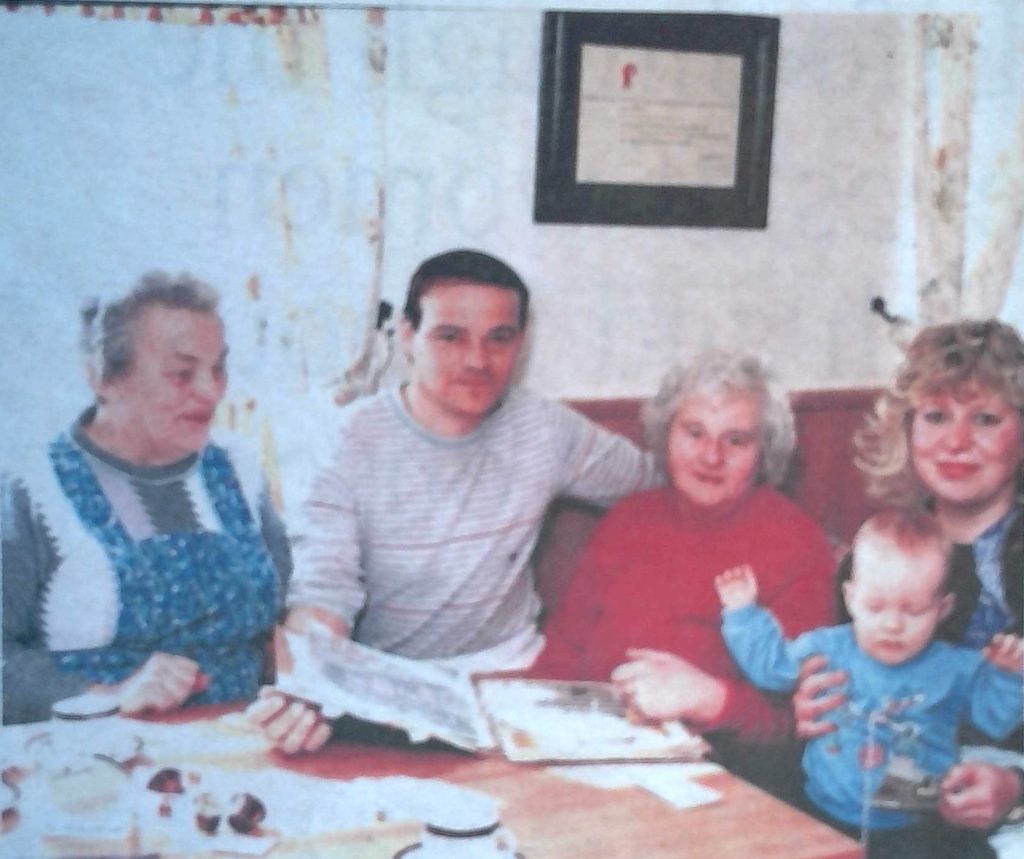
A newly qualified pilot flew from Bristol to Switzerland to mark the anniversary of the plane crash which claimed the lives of his father and grandmother. Roger Keen was 14 years old when father Roy, and grandmother, Louisa Davis, made a last- minute decision to join the shopping and sightseeing trip. Mr Keen, who grew up in Cheddar, said: “The first I heard about it was walking home from school. Someone said there had been a crash and I was told to go around to my uncle’s. Then we had to watch the TV for the names to be announced. It sticks in my mind, you don’t forget a moment like that.”
Mr Keen made a pledge to fly a plane to the scene of the tragedy and wife Janet helped him turn it into a reality . He was accompanied by 20-year-old RAF pilot Daniel Granger, from Bridgwater. “At the time of the crash and afterward, life seemed to go on more or less as normal but recently I seem to have been thinking about it a lot more, he said. “For me to fly to Switzerland to complete the flight my father never finished, to fly to Basle and go up the mountain to see the memorial that’s there, then hopefully it will draw a line under everything.”
Bad weather meant he had to delay his trip but he added: “Coming in to land you could see the snow capped mountains in the distance. Same runway, same direction – it all added to the sense of completion on landing. The following day Mr Keen made a sombre trek up to the mountainside to see the memorial in the woods where the plane had crashed “To me it’s a completion – it can never be final, just a laying to rest,” he said.
What investigators said about cause of the crash which destroyed lives
The Invicta International Airlines Vickers Vanguard was operating on a charter flight from Bristol (BRS) to Base Mulhouse (BSL). After entering the Base Mulhouse terminal area, the flight was cleared to continue to the BN NDB. Weather was poor at that time: cloud base at 120 m (390 feet) and a reported runway visual range of 700 (2300 feet) and 1300 m (4250 feet).
On arrival at the BN beacon the crew were cleared to descend to 2500 feet and were asked to report over the MN beacon before making a 90 degree left hand turn to finals for runway 16. At 09:56 the crew reported at 2500 feet, followed by a position report of the MN beacon at 09:57:40. When on finals over the BN beacon, the crew reported turning outbound and said they would report at the MN beacon again for another approach. When the crew reported overhead the BN beacon again.
Crash investigators fact overhead the airfield, flying parallel to the ILS localizer beam. After 1.5 minute the aircraft began to overshoot, correctly making an initial turn to the west. The crew, now flying well south of the field, were instructed to report back over the MN beacon. When reporting over the MN beacon again, before it would have to turn left for finals, the plane was in fact overhead the BS beacon, a beacon located to the south of runway 16.
At 10:11:25 the crew reported over the BN beacon on finals and was cleared to land. In fact the plane was now flying three miles south of the field and one mile west of the extended centerline. Two miles further on Basle ATC asked the crew “Are you sure you are over the BN?”. The captain replied “I think I’ve got a spurious indication. We are on the ILS now, sir” the LO… on
Half a minute later the captain radioed “BN is established on localizer and glide path; the ADF’s all over the place in this weather.” Last radio contact was when the captain reported at 1,400 feet, to which ATC replied that the flight was probably to the south of the airport.
At 10:13 the plane brushed against a wooded range of hills and crashed 15 km from the air- port.
The aircraft disintegrated, except for the tail section, were most of the survivors were found.
Probable Cause
“A loss of orientation during two ILS approaches carried out under instrument flight conditions. The following factors contributed to the occurrence of the accident: 1) inadequate navigation, above all imprecise initiation of final approach as regards height and approach center-line.; 2) confusion of aids; and 3) insufficient checking and comparison of navigational aids and instrument readings (cross and double checks). The poor reception of ht medium wave beacons and technical defects in LOC receiver No.1 and glide slope receiver no.2 made the crew’s navigational work more difficult.”
• (CFIT) – Mountain Sources:
• The Basle Vanguard accident, Flight International 18 Sep. 1975 (p. 404-405)
• Vanguard hearing: crew records and equipment faults cited, Flight International 14 Nov. 1974 (p. 666)
• Investigating agency: Air Accidents Investigation Branch
• AAIB) – United Kingdom Report status:
• Final Report number: AAIB AAR 11/ 1975


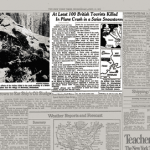
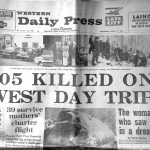
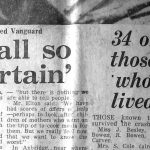
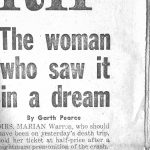
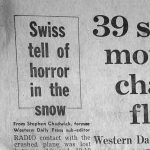
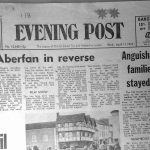
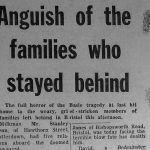
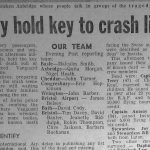
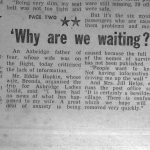
Leave a Reply